Plan your Gansu tour? Gansu Province is located in the northwest of China, lying in the transitional area between the Tibetan and Huangtu plateaus with the Yellow River passing through the southern part of the province.
Synonymous with the Silk Road, Gansu’s narrow strip of the land bounded between Qilian Mountains and Longshou Mountains known as Hexi Corridor was once the essential passage for the caravans hiking along the old silk road. The flowing trade and commerce left behind Buddhist temples, stone carved hills, ruined ancient cities and wild sections of the Great Wall.
Gansu has a rich minority and geographical diversity. Linxia is a Muslim dominated area also joined in by Bao’an and Dongxiang ethnic groups. The southern part of Gansu gives itself to the Tibetan area featured by the monastic towns of Xiahe and Langmusi.
Looking for the top things to do in Gansu. Here is our list of the Top 10 Places in Gansu.
1.Lanzhou 兰州
The capital city of Gansu Province is a springboard, extending your visit either to the Hexi Corridor to explore Jiayuguan and Dunhuang or the south in the Muslim and Tibetan favored grasslands, mosques and monasteries in Linxia Muslim Prefecture and Gannan Tibeten Prefecture ( Xiahe and Langmusi ) of Gansu Province. Lanzhou itself boast some interesting places to visit.
Major attractions
1) Gansu Provincial Museum
Gansu Provincial Museum was originlly built in 1956. Gansu Provincial Museum now covers an area of 180,000 square meters. There are nearly 100,000 relics in the museum, ranging from historical, modern, national relics, in which more than 3,000 pieces are of the first class and second class.
Entrance Fee: free
Opening Hours: 09:00-17:00 (closed on Monday)
How to get there: take Buses No. 1, 106 or 58 to You Yi Fan Dian Station
2) Waterwheel Garden
Lanzhou is regarded as “the city of waterwheel”. Waterwheel Garden, which is located in the Binhe East Road, was built by Duan Xu in the Ming Dynasty.It was used for irrigation of the farming fields along the Yellow River in ancient Lanzhou City.
Entrance Fee: CNY 10
Opening Hours: 08:00-18:00
How to get there: take Bus No. 15 to the Waterwheel Garden
3) Zhongshan Iron Bridge
Zhongshan Iron Bridge, located at the middle part of Riverside Road, is at the foot of White Pagoda Park in Lanzhou. It is the earliest bridge on the Yellow River which first built in 1372 and rebuilt in 1909.
Entrance Fee: free
Opening Hours: the whole day
How to get there: take Buses No. 2, 4, 6, 9, 13, 15, 101 or 102 to Xi Guan Shi Zi Station
4) Xiguan Mosque
Lanzhou Xiguan Mosque also named Jiefang Road Mosque and Guest Mosque due to the fact that the mosque was built using donations from Silk Road traders. The current Lanzhou Xiguan Mosque was constructed on its original site in 1983, similar to the style of Al-Aqas Mosque of Jerusalem.
Entrance Fee: CNY 10
Opening Hours: 08:00-19:00
How to get there: There is no direct bus to Xiguan Mosque. You can call a taxi or rent a car to get there
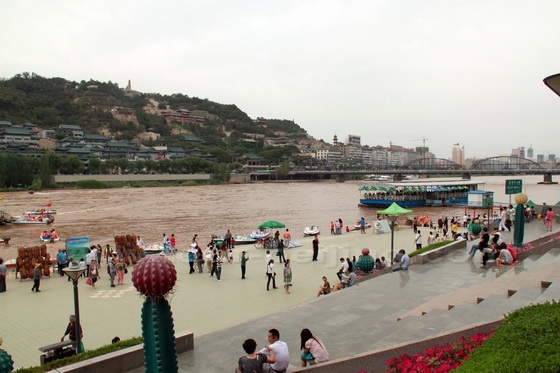
2.Tianshui 天水
In the middle way between Lanzhou and Xian, Tianshui is composed of two parts – the booming town (Beidao) and the old town (Qincheng)15km apart connected by a highway. Famous for the Buddhist roack carvings, Maji Shan is located 35km south of Beidao.
Major attractions
1)Maiji Shan Grottoes
As one of the four famous Grottoes in China with other three being Yungang Grottoes in Datong, Longmen Grottoes in Luoyang and Mogao Grottoes in Dunhuang, the Maijing Shan Grottoes are a series of 194 caves cut in the side of the hill Maijishan. This rock cut architecture contains over 7,200 Buddhist sculptures and over 1,000 square meters of murals, all of which built from 384AD to the Qin Dynasty (1644-1911).
2)Fuxi Temple
Fuxi Temple was built to commemorate Fuxi, who was the earliest ancestors of ancient China. The temple is a Ming Dynasty construction that, despite renovations in the Qing Dynasty, still retains its Ming format. Every year on January 15th (alleged birthday of the emperor) and May 13th (apparent birthday of China’s first dragon) by the Chinese traditional calendar, grand sacrificial ceremonies are held, which draw throngs of Chinese and foreigners to its door.
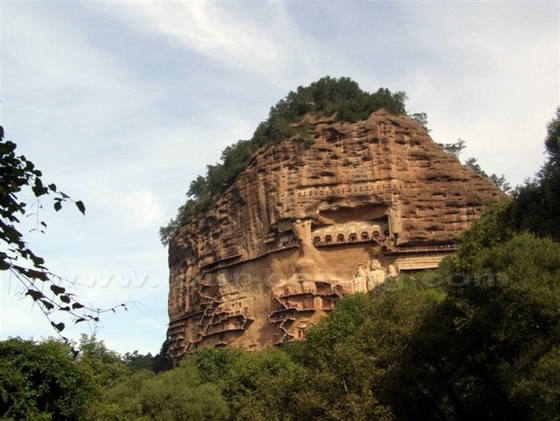
3.Wuwei 武威
Wuwei is the eastern end of the Hexi Corridoe. Han Tomb of Leitai is located in the old Leitai Park of Wuwei. Among the numerous unearthed artifacts the Bronze Flying Horse is the most valuable.
Major Attractions:
1) Han Tomb of Leitai – Han Tomb Of Leitai is located in the old Leitai Park of Wuwei. The tomb consists of 19.34 m long passage, 3 coffin chambers and 3 side chambers. There were 231 gold, silver, bronze, iron, jade, bone and pottery articles, and 99 bronze warriors and horses excavated from here, among which the Bronze Flying Horse is the most valuable.
2) Confucius Temple
Known as “Wenmiao” in Chinese, Confucius Temple was established in 1439 in honor of Confucius. It is the largest and best-preserved temple dedicated to Confucius in Gansu. The symmetrically aligned historic buildings together with the collections of stone steles and scriptures means that Confucian Temple possesses a very important position in the cultural heritage of the Chinese nation as a whole.
3) Haizang Temple
Haizang Temple, located 2km northwest of Wuwie city, is the largest complex of ancient buildings in Wuwei. The temple was opened as a park. The well preserved gateways, archways, pavilions and temples of Ming and Qing Dynasties are surrounded by river, lake and age-old trees, which make the park a quiet spot with its spectacular scenery.
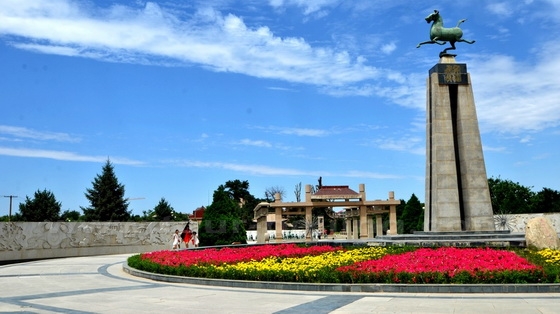
4.Zhangye 张掖
Zhangye is located in the middle section of the Hexi Corridor. Zhangye was an essential ancient town along the old silk road. The bell and drum tower in Zhangye, the biggest drum tower in the Hexi Corridor of the silk road district, was built in 1507.
Major Attractions:
1) The Giant Buddha Temple
The Giant Buddha Temple, with the original name Jiayerulaipian Temple is in the southeast part of Zhangye, which is the largest temple in Gansu. The great Buddhist Temple is 33 meters high. A Buddhist made up of wood, soil and plastic lies in the temple. It is said to be the largest lying Buddha in China.
2) The Bell Tower and Drum Tower
The bell and drum tower in Zhangye, the biggest drum tower in the Hexi Corridor of the silk road district, was built in 1507 during the Ming Dynasty. In 1648 during the Qing Dynasty, it was destroyed by war. In 1668, Zhang Yong, the superintendent of Gansu, rebuilt the bell and drum tower.
3) Zhangye Danxia Geopark
Danxia landform is formed from red-coloured sandstones and conglomerates of largely Cretaceous age. Danxia is the name of a particular place, but the name of a type of landform found in China, featured by prominent boulders and steep cliffs. It resembles karst rocks, but formed by layers of conglomerate instead of compact blocks of rock. The site Zhangye Danxia Gepark is about 33 km west of Zhangye’s city center.
4) Mati Temple ( Hoof Temple)
Mati Temple is situated in the foothills of Qilian Mountain range, about 65 km south of Zhanye. The temple is a combination of Buddhist grottoes, the picturesque Qilian Mountains and the local folklore. Totally there are over 70 caves.
5.Jiayuguan 嘉峪关
It is the symbolic end of the Great Wall and the western fringe of ancient China. Muse-visit attractions are Jiayuguan Fort, Overhanging Great Wall, Weijin Tombs…
Major Attractions
1) Jiayuguan Fort
Jiayu Pass ( Jiayuguan Fort ) was the first pass at the west end of the Great Wall of China. Built 1372, Jiayuguan Fortwas was christened as the first and greatest Pass under the Heaven. The pass consisted of three defense lines – an inner city, an outer city and a moat.
2) Suspension Great Wall
11kms to the downtown Jiayuguan City, the Suspension Great Wall was built on the ridge with the gradient of 45 degrees hence the name. From a distance, it is saide to resemble a dragon to extend its body towards the ground.
3) Wei-Jin Mural Tombs
Also named “Underground Art Gallery”, Wei-Jin Mural Tomb is a big tomb group with over 1, 400 tombs built between the 3rd century and 5th century during the Wei and Dynasties. It houses a great deal of colorful murals, the gallery. Most tombs are of families, housing bodies of three or four generations, and now only Grave 6 and Grave 7 are open for tourism.
4) July First Glacier 七一冰川
The famous July 1st Glacier sits on the high range of Qilian Mountains at 4300 meters, about 116 km southwest of Jiayuguan. The July First Galacier is the nearest visitable glacier to a city in Asia. The glacier was discovered in July 01, 1958, hence the name of July 1st Glacier.
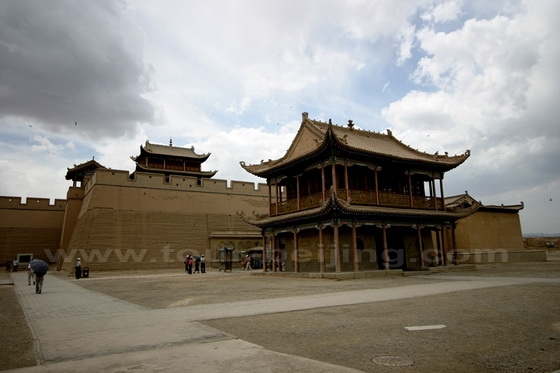
6.Dunhuang 敦煌
Once the mecca for the merchant Caravan, exiled poets and officials, now it is still an oasis for the silk raod travelers. Dunhuang once commanded a very important strategic position at the crossroads of the ancient Silk Road along the narrow Gansu Corridor which was extended to the north Chinese plains and the ancient capitals of Chang’ans and Luoyang.
Major Attractions
1) Mogao Caves
The site of the Mogao Caves is loated 25 km southeast of the city of Dunhuang. The Mogao Cave temples rise three levels along a 1.6 kilometer escarpment near the Daquan River. Every visitor to Dunhuang will be overpowered by their rich complexity and astonishing details. There are totally 492 caves, hand hewn from the cliff face over a millennium, are numbered for reference and protection.
2) Singing Sand Dunes
Echoing-Sand Dune is located on the southern outskirts, six kilometers from Dunhuang City. When people slide down on the sand of the mountain, it produces a ringing sound, hence its name “Echoing-Sand Dune” or Singing Sand Dunes.
3) Crescent Lake
Also called Yueyaquan in Chinese, the Crescent Lake is named so due to its surface in a crescent shape. To people’s surprise, the lucid and clear water in the lake had never dried up for thousands of years. The lake and the surrounding deserts are very popular with tourists, who are offered camel and 4×4 rides.
4) Dunhuang Museum
It is a local museum for keeping the cultural relics that were found in Dunhuang. The Dunhuang Museum reflects the flourishing social development and cultural exchange between China and the West during the time when Dunhuang was a major center along the Silk Road.
5) Yangguan Pass ( South Pass )
Yang Pass (Yangguan), also known as the Southern Pass, sits 75 kilometers southwest of Dunhuang, and was originally built by Emperor Wu in Hang Dynasty as one of the two most important passes protecting Dunhuang from invasion from the west (the other pass is Yumen Pass (Yumen Guan). Today, there are hardly any walls in sight, the only visible sections being the foundations of some of the walls.
6) Yumen Pass ( Jade Gate Pass )
Yumen Pass was a strategic pass on the ancient Silk Road and was built in order to ensure the safe and smooth of Silk Road in the Han Dynasty. It is said that the jade of Hetian in what is now Xinjiang region was transported to central China through this pass, hence the name “Yumen” which just means the gate of jade in Chinese.
7) Yadan National Park
180 km northwest of Dunhuang, the eroded and weird landform of Yadan lies in the Gobi desert. It is a UNESCO World Heritage crowned site with the strange rock formations formed by the former lake bed of over 12,000 years.
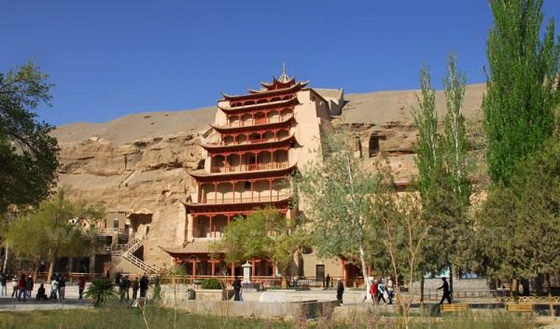
7.Linxia 临夏
Linxia is located 140km southeast of Lanzhou, 117km northeast of Xiahe, and 198km north of Hezuo, on the transit zone between the loess plateau and Qinghai-Tibet Plateau.
There are in total twenty-two ethnic groups living in Linxia, including Hui, Han, Dongxiang, Bonan, Salar, Tibetan and Tu. The Bonan and Dongxiang are unique to the prefecture and have thire own autonomous counties. Linxia has a population of 1.9 million with ethic groups taking 57%.
The Major Attraction in Linxia
Binglingsi Grottoes
The site of Binglingsi Grottoes is about 70km to the southwest of Lanzhou. “Bingling” means “ten of thousand Buddhus” in Tibetan language since there are many stone carved buddha sculptures here. Today the cliffs are isolated by the waters of Liujiaxia Reservoir on the Yellow River.
The site is well preserved, including 183 caves, 694 Buddha stone statues, 82 earth buddha statues, more than 900 square meters’mural painting which are scattered around the cliff of 200 meter long and 60 meter high on the west bank.
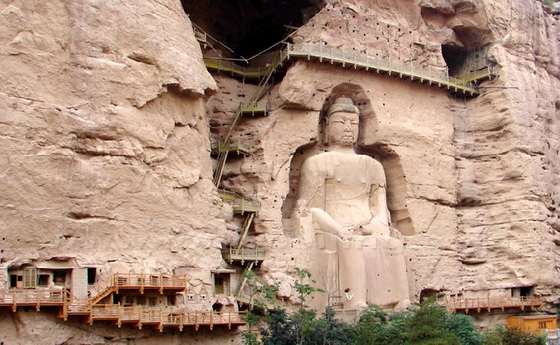
8.Xiahe 夏河
A monastic town nestled in a mountain valley, Xiahe attracts a great number of visitors each day. Its Labrang Monasery is one of the six major Tibetan monasteries of the Gelugpa.
Major Attractions
1 Labrang Monastery
Labrang Monastery is located on the north of Daxia River in the west of Xiahe County. This most important Tibetan monastery outside Tibet was first founded by Ngagong Tsunde, the first generation of Jamyang from nearby Ganjia in 1709. it is an important monastery of the Gelukpa or the Yellow Hat Sect. At its peak there were over 4000 monks. Currently there are over 3000 monks from Qinghai, Gansu, Inner Mongolia and Tibet as well.
2) Sangke Grasslands
Sangke Grasslands are a great expanse of pastures where Tibetans graze their yak herds. it was a pity that we didn’t have time coming here in the daytime to enjoy the lush green grassland and ride on horses. it was said that in summer Sangke Grasslands are at their best, green and abound with wildflowers.
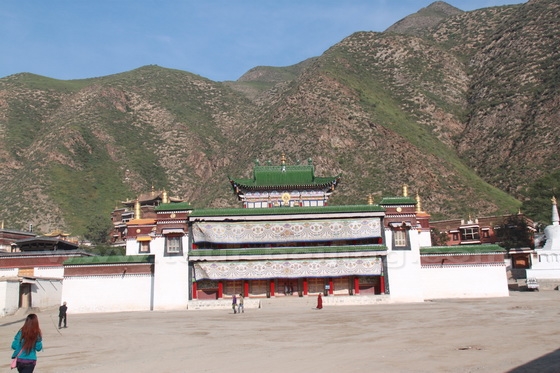
9.Hezuo 合作
Hezuo is the capital city of Gannan Tibetan Autonomous Prefecture of Gansu Province. It is located at the southeast fringe of Tibetan-Qinghai Plateau in the cross-border areas ofQinghai, Sichuan and Gansu provinces. The national highway No.223 runs through the city of Hezuo, which is 62km west of Xiahe, 260 km south of Lanzhou and 860km north of Chengdu with a average altitude of over 3000 meters.
About 2km outside the city center of Hezuo is the famous Hezuo Milariba Buddha Pavilion, which was built in 1777. It has an interior nine storeys painted with colorful murals and Tantric deities.
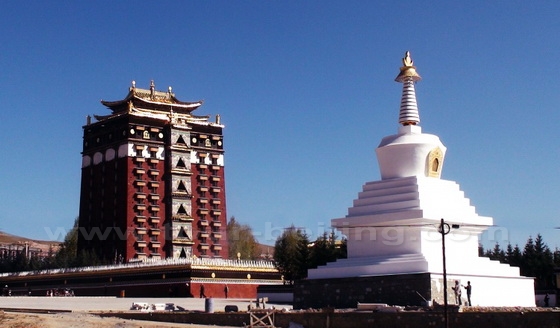
10.Langmusi 郎木寺
On the border between Gansu and Sichuan, Langmusi is an alpine Amdo Tibetan Village nestled in in a valley of steep grassy meadows and the evergreen trees of pine trees. Kerti Gompa on Sichuan side and Serti Gompa on the Gansu side are the highlights of the village.
It is easy to spend a few days here exploring the numerous red and white monastery buildings and hiking around the green mountains. The surounding mountains reminds people of the rural Austria or Bavaria and ideal for hiking and horsetrek.
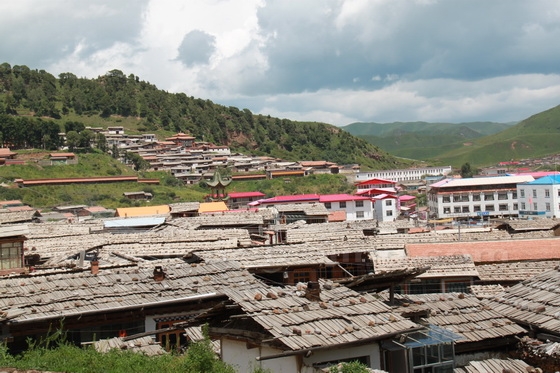
Further Readings
Lanzhou Tour
Gansu Tour
Top 10 Attractions in Lanzhou
Top 10 Places in Gansu
How to Enjoy Nightlife in Lanzhou
Lanzhou Zhangye Road Pedestrian Street
Zhengning Road Night Snack Market in Lanzhou
Lanzhou Bar Street
Lanzhou Antique Market
Lanzhou Waterwheel Park
Lanzhou Zhongshan Bridge
Lanzhou City Layout
How to visit Gansu Museum
Lanzhou Yintan Wetland Park
Lanzhou Zhongchuan Airport
Lanzhou Railway Station
Lanzhou Xiguan Mosque
Where to stay in Lanzhou
Yellow River, the Mother River of China
Any questions, just drop a line.





